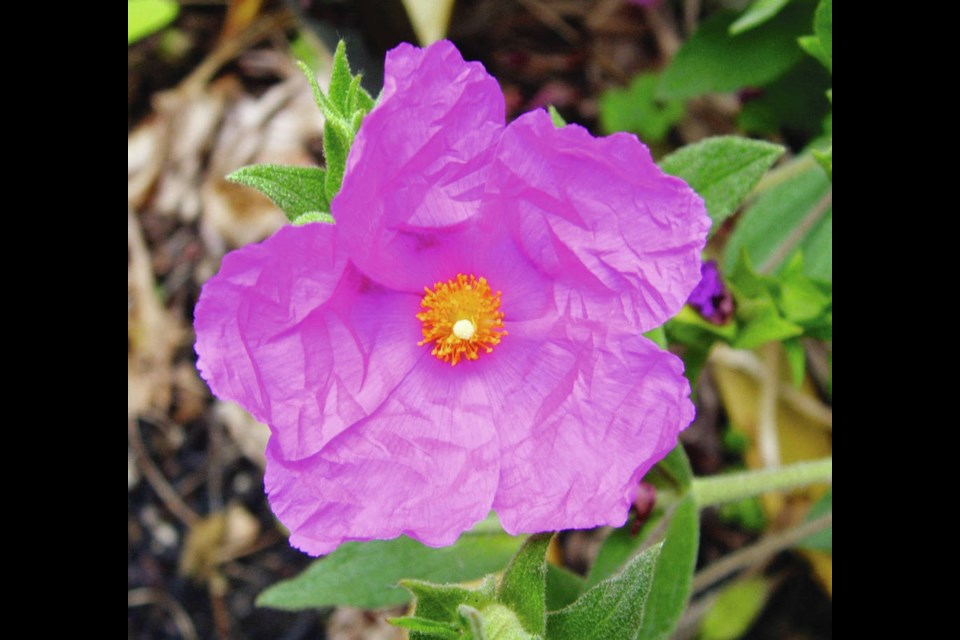Dear Helen: Are “sun rose” and “rock rose” the same plant?
M.P.
Two separate plants are each known by both these common names. It is a bit confusing for those among us with a penchant for precision.
Whenever confronted with a confusion among plant names, I consult the Royal Horticultural Society Index of Garden Plants. This esteemed reference gives the common names rock rose and sun rose to both Helianthemum and Cistus.
The name Helianthemum is from the Greek helios, the sun, and anthemon, a flower. Hence the name sun rose. The plants are evergreen creepers that form low, spreading mats. Small, rose-like flowers appear in early summer. The plants are well suited for growing in rock gardens.
Helianthemum plants sold in garden centres are usually hybrids. My best plants, still in the garden, are grown from Helianthemum nummularium seeds I found in my father’s office soon after his death. The small packet held a colour mixture of the species. My plants yield yellow and orange flowers.
Cistus plants are small to mid-sized evergreen shrubs that bear single, open-faced flowers, often with crinkled petals, in early summer. One of my purchased plants, labelled “Sunset,” is also sold as “Brilliancy.”
My most compact, shapely, and flower-filled Cistus is the seed-grown Pink Silk. Plant World Seeds returned the listing for it to this year’s catalogue.
Both Cistus and Helianthemum are Mediterranean plants like lavender and rosemary, with a preference for similar growing conditions: a very well-drained soil, and full sun. Both are drought tolerant once established.
Dear Helen: My sweet peas are growing beautifully. The plants are strong and healthy. Problem: No blooms. Why?
W.D.
I’ve received similar questions this year about annuals, sweet peas and snapdragons among them, not blooming in late June, before the heat wave happened. The sudden onset of very hot weather may well have brought on flowers. There was a rather startling switch from cool weather to blazing heat at the end of June.
Here are some common reasons for delayed flowering:
The variety. Most annual flowers are available in a wide range of varieties offering choices in plant height, flower colour, and time from planting to flowering. Catalogues and seed packets don’t usually provide information on the time period to “maturity” (planting to picking) for flowers. They do for vegetable varieties. When earliness is a crucial issue for flowers, help in choosing varieties can often be found on the internet.
Weather. Cool weather can delay the onset of flowerbud formation while helping to nurture good green growth.
Growing conditions. Prolific green growth and no flowers can indicate over-watering or/and an excess of nitrogen in the soil. Some purchased composts and soil amendments are nitrogen-rich. For flowering plants, use fertilizers that are close to evenly balanced among the three main nutrients: nitrogen, phosphorus, and potassium — nitrogen (N) for good green growth, phosphorus (P) for root and flowerbud development, potassium (K) for general strength in plants. These three “macronutrients” are represented by three numbers, in N-P-K order, on fertilizer labels.
Dear Helen: My tomatoes were blooming when the heat wave struck, with temperatures up to 35 C for several days. I don’t see little tomatoes forming. Do you think the heat may have damaged the flowers?
L.T.
Some damage may have been done to tomato flowers during the hottest days. I recorded temperatures of 31 C to 34.5 C over five consecutive days. Temperatures over 30 C can damage flowers enough to affect fruit shape and flavour. Temperatures over 32 C can sterilize pollen.
These are general parameters. All we can do is keep nurturing and observing our plants — and wait. I am hoping that, among the ten varieties I am growing, some will prove extra resilient to the heat.
Even if there has been damage, staked (indeterminate) tomatoes will continue to grow and produce more flowers, hopefully in more normally moderate and congenial temperatures, for us and the tomato plants.
Such a significant blip in our usual early summer weather pattern has propelled me to water the tomatoes, zucchinis, winter squash and other food plantings slowly and deeply before mulching them with a nourishing compost and then laying a loose cushion of straw around the bases to deflect sunlight, shade and cool the soil, and conserve moisture.



